 Entrance to the Royal Palace of Ugarit | |
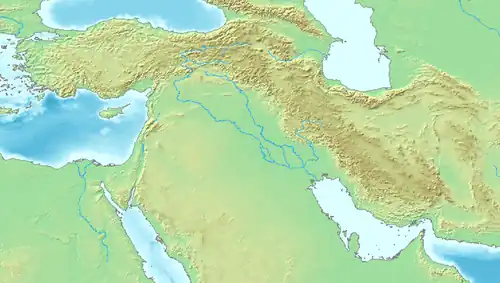 Shown within Near East 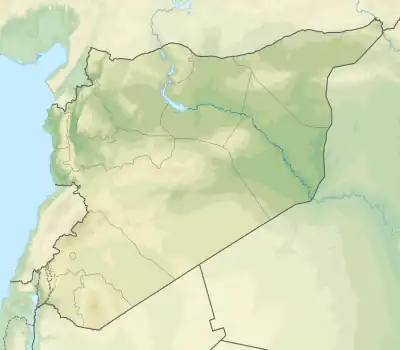 Ugarit (Syria) | |
| Alternative name | Ras Shamra (Arabic: رأس شمرة) |
|---|---|
| Location | Latakia Governorate, Syria |
| Region | Fertile Crescent |
| Coordinates | 35°36′07″N 35°46′55″E / 35.602°N 35.782°E |
| Type | settlement |
| History | |
| Founded | c. 6000 BC |
| Abandoned | c. 1185 BC |
| Periods | Neolithic–Late Bronze Age |
| Cultures | Canaanite |
| Events | Bronze Age Collapse |
| Site notes | |
| Excavation dates | 1928–present |
| Archaeologists | Claude F. A. Schaeffer |
| Condition | ruins |
| Ownership | Public |
| Public access | Yes |
Ugarit (/juːˈɡɑːrɪt, uː-/;[1] Ugaritic: 𐎜𐎂𐎗𐎚, ʾUgarītu) was an ancient Canaanite port city in northern Syria,[2] in the outskirts of modern Latakia. It was discovered by accident in 1928 with the Ugaritic texts.[3] Its ruins are often called Ras Shamra[note 1] after the headland where they lie.
Ugarit saw its beginnings in the Neolithic period and continued as a settlement through the Chalcolithic and Bronze Ages.[2] The city had close connections to the Hittite Empire, sent tribute to Egypt at times, and maintained trade and diplomatic connections with Cyprus (then called Alashiya),[4][5] documented in the archives recovered from the site and corroborated by Mycenaean and Cypriot pottery found there. The polity was at its height from c. 1450 BC until its destruction in c. 1185 BC;[6] this destruction was possibly caused by the purported Sea Peoples, or an internal struggle. The kingdom would be one of the many dismantled during the Bronze Age Collapse.
History
Ras Shamra lies on the Mediterranean coast, some 11 kilometres (7 mi) north of Latakia, near modern Burj al-Qasab.
Origins and the second millennium

Neolithic Ugarit was important enough to be fortified with a wall early on, perhaps by 6000 BC, though the site is thought to have been inhabited earlier. Ugarit was important perhaps because it was both a port and at the entrance of the inland trade route to the Euphrates and Tigris lands. The city reached its heyday between 1800 and 1200 BC, when it ruled a trade-based coastal kingdom, trading with Egypt, Cyprus, the Aegean, Syria, the Hittites, and much of the eastern Mediterranean.[7] M. Liverani approximated the population to be between 6,000 and 8,000 individuals.[2]
The first written evidence mentioning the city comes from the nearby city of Ebla, c. 1800 BC. Ugarit passed into the sphere of influence of Egypt, which deeply influenced its art. Evidence of the earliest Ugaritic contact with Egypt (and the first exact dating of Ugaritic civilization) comes from a carnelian bead identified with the Middle Kingdom pharaoh Senusret I, 1971–1926 BC. A stela and a statuette from the Egyptian pharaohs Senusret III and Amenemhet III have also been found. However, it is unclear at what time these monuments were brought to Ugarit. Amarna letters from Ugarit c. 1350 BC record one letter each from Ammittamru I, Niqmaddu II, and his queen. From the 16th to the 13th century BC, Ugarit remained in regular contact with Egypt and Alashiya (Cyprus).
In the second millennium BC, Ugarit's population was Amorite, and the Ugaritic language probably has a direct Amoritic origin.[8] The kingdom of Ugarit may have controlled about 2,000 km2 on average.[8]
During some of its history it would have been in close proximity to, if not directly within, the Hittite Empire.
Destruction
The last Bronze Age king of Ugarit, Ammurapi (circa 1215 to 1180 BC), was a contemporary of the last known Hittite king, Suppiluliuma II. The exact dates of his reign are unknown. However, a letter[9] by the king is preserved, in which Ammurapi stresses the seriousness of the crisis faced by many Near Eastern states due to attacks. Ammurapi's response to an appeal for assistance from the king of Alashiya highlights the desperate situation that Ugarit and other cities faced:
My father, behold, the enemy's ships came (here); my cities(?) were burned, and they did evil things in my country. Does not my father know that all my troops and chariots(?) are in the Land of Hatti, and all my ships are in the Land of Lukka? ... Thus, the country is abandoned to itself. May my father know it: the seven ships of the enemy that came here inflicted much damage upon us.[10]
Eshuwara, the senior governor of Cyprus, responded:
As for the matter concerning those enemies: (it was) the people from your country (and) your own ships (who) did this! And (it was) the people from your country (who) committed these transgression(s) ... I am writing to inform you and protect you. Be aware![11]
The ruler of Carchemish sent troops to assist Ugarit, but Ugarit had been sacked. A letter sent after Ugarit had been destroyed said:
When your messenger arrived, the army was humiliated and the city was sacked. Our food in the threshing floors was burnt and the vineyards were also destroyed. Our city is sacked. May you know it! May you know it![12]
By excavating the highest levels of the city's ruins, archaeologists can study various attributes of Ugaritic civilization just before their destruction, and compare artifacts with those of nearby cultures to help establish dates. Ugarit also contained many caches of cuneiform tablets, actual libraries that contained a wealth of information. The destruction levels of the ruin contained Late Helladic IIIB pottery ware, but no LH IIIC (see Mycenaean period). Therefore, the date of the destruction of Ugarit is important for the dating of the LH IIIC phase in mainland Greece. Since an Egyptian sword bearing the name of pharaoh Merneptah was found in the destruction levels, 1190 BC was taken as the date for the beginning of the LH IIIC. A cuneiform tablet found in 1986 shows that Ugarit was destroyed after the death of Merneptah (1203 BC). It is generally agreed that Ugarit had already been destroyed by the eighth year of Ramesses III (1178 BC). Recent radiocarbon work, combined with other historical dates and the eclipse of January 21, 1192, indicates a destruction date between 1192 and 1190 BC.[13]
A large number of arrowheads were recovered from the destruction level. Their typology has not been published as yet.[14]
Kings
| Ruler | Reigned | Comments |
|---|---|---|
| Niqmaddu I | Unknown | First known Ugaritan king, known only from a damaged seal that mentions "Yaqarum, son of Niqmaddu, king of Ugarit".[15] |
| Yaqarum | Unknown | Second known Ugaritan king, known only from a damaged seal that mentions "Yaqarum, son of Niqmaddu, king of Ugarit".[15] |
| Ammittamru I | c. 1350 BC | |
| Niqmaddu II | c. 1350–1315 BC | Contemporary of Suppiluliuma I of the Hittites |
| Arhalba | c. 1315–1313 BC | Contemporary of king Mursili II of the Hittites |
| Niqmepa | c. 1313–1260 BC | Treaty with Mursili II of the Hittites; Son of Niqmadu II |
| Ammittamru II | c. 1260–1235 BC | Contemporary of Bentisina of Amurru; Son of Niqmepa |
| Ibiranu | c. 1235–1225/20 BC | Addressee of the letter of Piha-walwi |
| Niqmaddu III | c. 1225/20 – 1215 BC | |
| Ammurapi | c. 1200 BC | Contemporary of Chancellor Bay of Egypt. Last known ruler of Ugarit. Ugarit is destroyed in his reign. |
Language and literature
| Ugarit |
|---|
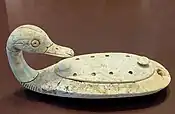 |
| Places |
| Kings |
| Culture |
| Texts |
Alphabet
Scribes in Ugarit appear to have originated the "Ugaritic alphabet" around 1400 BC: 30 letters, corresponding to sounds, were inscribed on clay tablets. Although they are cuneiform in appearance, the letters bear no relation to Mesopotamian cuneiform signs; instead, they appear to be somehow related to the Egyptian-derived Phoenician alphabet. While the letters show little or no formal similarity to the Phoenician, the standard letter order (seen in the Phoenician alphabet as ʔ, B, G, D, H, W, Z, Ḥ, Ṭ, Y, K, L, M, N, S, ʕ, P, Ṣ, Q, R, Š, T) shows strong similarities between the two, suggesting that the Phoenician and Ugaritic systems were not wholly independent inventions.[16]
Ugaritic language
The existence of the Ugaritic language is attested to in texts from the 14th through the 12th century BC. Ugaritic is usually classified as a Northwest Semitic language and therefore related to Hebrew, Aramaic, and Phoenician, among others. Its grammatical features are highly similar to those found in Classical Arabic and Akkadian. It possesses two genders (masculine and feminine), three cases for nouns and adjectives (nominative, accusative, and genitive); three numbers: (singular, dual, and plural); and verb aspects similar to those found in other Northwest Semitic languages. The word order in Ugaritic is verb–subject–object, subject-object-verb (VSO)&(SOV); possessed–possessor (NG) (first element dependent on the function and second always in genitive case); and noun–adjective (NA) (both in the same case (i.e. congruent)).[17]
Ugaritic literature

Apart from royal correspondence with neighboring Bronze Age monarchs, Ugaritic literature from tablets found in the city's libraries include mythological texts written in a poetic narrative, letters, legal documents such as land transfers, a few international treaties, and a number of administrative lists. Fragments of several poetic works have been identified: the "Legend of Keret", the "Legend of Danel", the Ba'al tales that detail Baal-Hadad's conflicts with Yam and Mot, among other fragments.[18]
The discovery of the Ugaritic archives in 1929 has been of great significance to biblical scholarship, as these archives for the first time provided a detailed description of Canaanite religious beliefs, during the period directly preceding the Israelite settlement. These texts show significant parallels to Hebrew biblical literature, particularly in the areas of divine imagery and poetic form. Ugaritic poetry has many elements later found in Hebrew poetry: parallelisms, metres, and rhythms. The discoveries at Ugarit have led to a new appraisal of the Hebrew Bible as literature.
Religion
The important textual finds from the site shed a great deal of light upon the cultic life of the city.[19]
The foundations of the Bronze Age city Ugarit were divided into quarters. In the north-east quarter of the walled enclosure, the remains of three significant religious buildings were discovered, including two temples (of the gods Baal Hadad and Dagon) and a building referred to as the library or the high priest's house. Within these structures atop the acropolis numerous invaluable mythological texts were found. These texts have provided the basis for understanding of the Canaanite mythological world and religion. The Baal of Ugarit was likely the same as the Baal of the Hebrew Bible.[20][21] The Baal cycle represents Baal Hadad's destruction of Yam (the god of chaos and the sea), demonstrating the relationship of Canaanite chaoskampf with those of Mesopotamia and the Aegean: a warrior god rises up as the hero of the new pantheon to defeat chaos and bring order.
Ugaritic mythology viewed the forces of chaos and the cosmic energies of chaos as divine despite them opposing heroic gods.[22]
Archaeology
The site is a 20m (65 foot) high mound. Archaeologically, Ugarit is considered quintessentially Canaanite.[23]
Discovery and excavations
After its destruction in the early 12th century BC,[24] Ugarit's location was forgotten until 1928 when a peasant accidentally opened an old tomb while ploughing a field. The discovered area was the necropolis of Ugarit located in the nearby seaport of Minet el-Beida. Excavations have since revealed a city with a prehistory reaching back to c. 6000 BC.[25]
A brief investigation of a looted tomb at the necropolis of Minet el-Beida was conducted by Léon Albanèse in 1928, who then examined the main mound of Ras Shamra.[26] But in the next year scientific excavations of Tell Ras Shamra were commenced by archaeologist Claude Schaeffer from the Musée archéologique in Strasbourg.[27] Work continued under Schaeffer until 1970, with a break from 1940 to 1947 because of World War II.[28][29][30]
City layout and main sites
Excavations have unveiled two significant areas within Ugarit. The first is situated in the north-west, identified as the royal palace. This sector housed a fortified gate on its west side, offering access solely to the palace area and not to the city proper. The primary entrance into the city, likely used by farmers, traders, and others, is believed to have been in the south, where the road intersected the southern stream. Ongoing excavation aims to substantiate this hypothesis.[2]
The second crucial sector, located in the north-east, encompasses the city's acropolis. This area hosts the primary religious structures: two temples dedicated to the main city deities, one to Baal the "king", son of El, and one to Dagon, the chthonic god of fertility and wheat. 23 stelae were unearthed: nine stelae, including the famous Baal with Thunderbolt, near the Temple of Baal, four in the Temple of Dagon and ten more at scattered places around the city.[31] Adjacent to this area stood the House of the Chief Priest, alternatively referred to as the Library.[2]
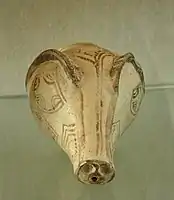
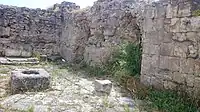 Remains of the ancient city, some walls and what appears to be a small well.
Remains of the ancient city, some walls and what appears to be a small well.
Royal palace
The Royal Palace, typical of East Mediterranean and Near Eastern architecture, was constructed over several major phases between the 15th and 13th centuries BC. It comprised rooms arranged around courtyards, encompassing 6,500 square meters before the city's destruction in the early 12th century BC. A tablet from the 14th century BC found in the Amarna archives mentions a prince of Byblos likening the palace at Tyre to the grandeur found in the palace within Ugarit's walls.[2]
The palace exhibited exceptional construction quality, predominantly crafted from stone, with preserved ashlar blocks reaching heights of up to 4 meters. Wooden crossbeams were also incorporated, inserted into slots within the stone masonry. A thick layer of plain plaster covered the walls.[2]
The ground level of the palace housed numerous rooms, courts, and a tower by the entrance, besides featuring a large garden at the rear. These rooms catered to various functions, including public receptions, administration, archives, storage, guard facilities, and staff lodging. The ground floor's layout lacks symmetry, reflecting incremental modifications made over time. Irregular in shape, the north facade, bordering a major street, displayed intermittent recesses and protrusions. The main entrance, noticeably positioned asymmetrically in the north-west, was distinct, featuring a paved porch supported by two wooden columns on stone bases, stone benches on either side, and a security tower on the southern end. Smaller entrances were situated in the north-east and south-west.[32]
Archaeological findings within the ruins have included a diverse variety of artifacts such as ivory carvings, stone stelae, figurines, and numerous tablets. These tablets were discovered in archives located across the palace; their contents encompass reports on outlying regions, judicial records—particularly from the south-central archives of the palace—and examples of practice writing by young scribes. Initial excavation reports indicated the presence of an oven within the south court, supposedly used for baking clay tablets for permanent preservation. However, recent research has raised doubts about the existence of such an oven and the context of the tablets discovered in this area. These tablets may form part of a larger collection scattered from the upper story mixed with debris from the palace's fire during its destruction.[33]
Below ground, beneath two northern rooms, lay family tombs—three spacious chambers constructed with corbelled vaults—found devoid of any contents. The vanished upper floor likely accommodated the private quarters of the royal family, accessed via twelve staircases.[34]
Acropolis
The Acropolis, positioned in the Ugarit's northeastern section, housed the city's primary temples dedicated to Baal and his father, Dagan, both deities associated with vegetation. Though the existing remnants date to the Late Bronze Age, these temples might have their origins in the early second millennium BC. Stelai discovered in this area portray or name these gods, affirming their identification for the respective cults. Within the Temple of Baal, discoveries include a stele depicting Baal holding a club aloft, portrayed in a typical Near Eastern and Egyptian artistic style. Numerous statues, stelai—some offered by Egyptians—and sixteen stone anchors were found as votive offerings in this vicinity.[2]
The temple layouts share simplicity and resemblance. Each comprises a pronaos (porch) and a naos (sanctuary proper), aligned from north-northeast to south-southwest. The Temple of Dagan stands out for its 4–5-meter-thick foundation walls. Remnants of the Temple of Baal encompass sections of an enclosing wall, a likely courtyard altar, imposing steps leading to the elevated pronaos and naos, and another presumed altar within the naos. Marguerite Yon speculated that these elevated structures might have also served as lighthouses.[2]
Another significant structure within the Acropolis was the House of the High Priest, situated west of the Temple of Dagan. This large, two-story residence, largely well-constructed, garnered significance for housing tablets containing mythological poems. Some tablets demonstrated writing exercises and included syllabic and bilingual lexicons, implying the building's use as a center for scribe training. Its proximity to the primary temples and the discovery of bronze tools, particularly four small adzes and a dedicated hoe, hints at its potential role as the residence of the city's chief priest. Among a cache of seventy-four bronze items uncovered beneath a doorway threshold inside the house, was an elegant tripod adorned with pomegranate-shaped pendants.[2]
Ugarit port (Minet el Beida)
The port of ancient Ugarit was located 1.5 kilometers away from the main city, at the natural harbor of Minet el Beida (Arabic for "White Harbor"[35]).[2][36] Archaeological excavations carried out on the southern side of the bay, now reduced in size due to alluvial fill, unveiled remnants of a settlement established in the 14th century BC, and perhaps earlier, in the late 15th century.[2][37] This port town, featuring an urban layout akin to the city of Ugarit, displays irregular street formations. Dwellings were structured around courtyards with adjacent rooms, including provisions like wells, ovens, and occasionally subterranean tombs. Besides residential spaces and shrines, warehouses were present for storing diverse goods earmarked for import or export. One of them was discovered still housing eighty shipping jars that remain remarkably intact.[2]
Artifacts discovered in the port indicate the predominance of native Ugaritians within the local populace, accompanied by a significant presence of various foreign communities such as Egyptians, Cypriots, Hittites, Hurrians, and Aegean peoples. Among the discoveries were Cypriot pottery (both imported and locally crafted), Mycenaean pottery, ivory cosmetic containers from Egypt, a terracotta depiction of Hathor, bronze tools and weaponry, cylinder seals, stone weights, remnants of murex shells used in the production of purple dye, and inscribed tablets.[2]
Texts
On excavation of the site, several deposits of cuneiform clay tablets were found. These have proven to be of great historical significance.
See also
Explanatory notes
References
Citations
- ↑ "Ugarit". Merriam-Webster.com Dictionary.
- 1 2 3 4 5 6 7 8 9 10 11 12 13 14 Gates, Charles (2011). Ancient cities: the archaeology of urban life in the ancient Near East and Egypt, Greece and Rome (2nd ed.). London: Routledge. pp. 157–164. ISBN 978-0-203-83057-4.
- ↑ Huehnergard, John (2012). An Introduction to Ugaritic. Hendrickson Publishers. ISBN 978-1-59856-820-2.
- ↑ Commercial and diplomatic relations between Cyprus and Ugarit are well documented in the Late Bronze Age and the close ties that existed between Ugarit and Cyprus can be seen.
- ↑ "Searching for the Lost City of Copper". History Magazine. 2017-03-23. Archived from the original on November 25, 2020. Retrieved 2021-01-15.
- ↑ Kemp, Luke, and Eric H. Cline, (2022). "Systemic Risk and Resilience: The Bronze Age Collapse and Recovery", in: Adam Izdebski, John Haldon, and Piotr Filipkowski (eds.), Perspectives on Public Policy in Societal-Environmental Crises, Springer, pp. 207-223.
- ↑ Bahn, Paul (1997). Lost Cities: 50 Discoveries in World Archaeology. London: Barnes & Noble. pp. 98–99.
- 1 2 Pardee, Dennis. "Ugaritic", in The Ancient Languages of Syria-Palestine and Arabia (2008) (pp. 5–6). Roger D. Woodard, editor. Cambridge University Press, ISBN 0-521-68498-6, ISBN 978-0-521-68498-9 (262 pages).
- ↑ Letter RS 18.147
- ↑ Jean Nougaryol et al. (1968) Ugaritica V: 87–90 no. 24
- ↑ Cline, Eric H. (2014). Translation of letter RS 20.18 in "1177 B.C.: The Year Civilization Collapsed". Princeton University Press. p. 151.
- ↑ Cline, p. 151
- ↑ "The Sea Peoples, from Cuneiform Tablets to Carbon Dating." Kaniewski D, Van Campo E, Van Lerberghe K, Boiy T, Vansteenhuyse K, et al., PLoS ONE 6(6), 2011
- ↑ Boyes, Philip J. “The Impact and Legacy of Alphabetic Cuneiform.” Script and Society: The Social Context of Writing Practices in Late Bronze Age Ugarit, Oxbow Books, 2021, pp. 261–76.
- 1 2 Smith, Mark S. (1994). The Ugaritic Baal Cycle: Volume I, Introduction with text, translation and commentary of KTU 1.1-1.2. p. 90. ISBN 9789004099951.
- ↑ Archived 2012-10-08 at the Wayback Machine Dennis Pardee, "The Ugaritic Alphabetic Cuneiform Writing System in the Context of Other Alphabetic Systems", (in Studies in Ancient Oriental Civilization, vol. 60, pp. 181–200, Oriental Institute, 2007)
- ↑ Stanislav Segert, A basic Grammar of the Ugaritic Language: with selected texts and glossary (1984) 1997.
- ↑ Nick Wyatt. Religious texts from Ugarit, (1998) rev. ed 2002.
- ↑ Gregorio Del Olmo Lete, Canaanite Religion: According to the Liturgical Texts of Ugarit, 2004.
- ↑ R. A. Oden, Jr., "Baal Samem and El", Catholic Biblical Quarterly 39, no.4. pp. 457–73, 1977
- ↑ Mark S. Smith, "The Early History of God: Yahweh and the Other Deities in Ancient Israel", 2nd ed. Grand Rapids, Mich.: Eerdmans, pp. 65–75, 2002
- ↑ McGrath, Alister E. (May 2005). Theology: The Basics. Oxford: Blackwell Publishing. p. 36. ISBN 978-1-4051-1425-7.
- ↑ Tubb, Jonathan N. (1998), "Canaanites" (British Museum People of the Past)
- ↑ "Ugarit | ancient city, Syria". Encyclopedia Britannica. Retrieved 2021-01-15.
- ↑ Yon, Marguerite (2006). The City of Ugarit at Tell Ras Shamra. Singapore: Eisenbrauns. p. 15. ISBN 978-1-57506-029-3. Retrieved 16 May 2015.
- ↑ Léon Albanèse, "Note sur Ras Shamra", Syria, vol. 10, pp. 16–21, 1929
- ↑ Charles Virolleaud, "Les Inscriptions Cunéiformes de Ras Shamra", Syria, vol. 10, pp. 304–310 (1929); Claude F. A. Schaeffer, The Cuneiform Texts of Ras Shamra-Ugarit (1939).
- ↑ Claude F. A. Schaeffer, The Cuneiform Texts of Ras Shamra-Ugarit: The Schweich Lectures of the British Academy 1937, Periodicals Service Co., 1986. ISBN 3-601-00536-0.
- ↑ Claude F. A. Schaeffer et al., Le Palais Royal D'Ugarit III: Textes Accadiens et Hourrites Des Archives Est, Ouest et Centrales, Two Volumes (Mission De Ras Shamra Tome VI), Imprimerie Nationale, 1955.
- ↑ Sauvage, Caroline, and Christine Lorre, ed., "À la découverte du royaume d'Ougarit (Syrie du IIe millénaire). Les fouilles de C.F.A. Schaeffer à Minet el-Beida et Ras Shamra (1929‒1937)", Austrian Academy of Sciences Press (Contributions to the Archaeology of Egypt, Nubia and the Levant 7, 2023
- ↑ Caubet, Annie. "Stela Depicting the Storm God Baal". Musée du Louvre. Retrieved 27 October 2012.
- ↑ Gates, Charles (2011). Ancient cities: the archaeology of urban life in the ancient Near East and Egypt, Greece and Rome (2nd ed.). London: Routledge. pp. 157–164. ISBN 978-0-203-83057-4.
- ↑ Gates, Charles (2011). Ancient cities: the archaeology of urban life in the ancient Near East and Egypt, Greece and Rome (2nd ed.). London: Routledge. pp. 157–164. ISBN 978-0-203-83057-4.
- ↑ Gates, Charles (2011). Ancient cities: the archaeology of urban life in the ancient Near East and Egypt, Greece and Rome (2nd ed.). London: Routledge. pp. 157–164. ISBN 978-0-203-83057-4.
- ↑ Morton, W. H. (1948). Ras Shamra-Ugarit and Old Testament Exegesis. Review & Expositor, 45(1), 63-80.
- ↑ Schaeffer, F. A. (1930). The French Excavations at Minet el Beida and Ras Shamra in Syria. Antiquity, 4(16), 460-466.
- ↑ Curtis, A. H. (1999). Ras Shamra, Minet el-Beida and Ras Ibn Hani: The Material Sources. In Handbook of Ugaritic studies (pp. 5-27). Brill.
General sources
- internal strugle Annalee Newitz, What Happened to the Original 1 Percent?, New York Times, May 11, 2020
- Ugarit Forschungen (Neukirchen-Vluyn). UF-11 (1979) honors Claude Schaeffer, with about 100 articles in 900 pages. pp. 95, ff, "Comparative Graphemic Analysis of Old Babylonian and Western Akkadian", ( i.e. Ugarit and Amarna (letters), three others, Mari, OB,Royal, OB,non-Royal letters). See above, in text.
- Bourdreuil, P. 1991. "Une bibliothèque au sud de la ville : Les textes de la 34e campagne (1973)". in Ras Shamra-Ougarit, 7 (Paris).
- Caquot, André & Sznycer, Maurice. Ugaritic Religion. Iconography of Religions, Section XV: Mesopotamia and the Near East; Fascicle 8; Institute of Religious Iconography, State University Groningen; Leiden: E.J. Brill, 1980.
- Drews, Robert. 1995. The End of the Bronze Age: Changes in Warfare and the Catastrophe ca. 1200 BC (Princeton University Press). ISBN 0-691-02591-6
- de Moor, Johannes C. The Seasonal Pattern in the Ugaritic Myth of Ba'lu, According to the Version of Ilimilku. Alter Orient und Altes Testament, Band 16. Neukirchen – Vluyn: Verlag Butzon & Berker Kevelaer, Neukirchener Verlag des Erziehungsvereins, 1971
- Gibson, J.C.L., originally edited by G.R. Driver. Canaanite Myths and Legends. Edinburgh: T. and T. Clark, Ltd., 1956, 1977.*K. Lawson and K. L. Younger Jr, "Ugarit at Seventy-Five," Eisenbrauns, 2007, ISBN 1-57506-143-0
- L'Heureux, Conrad E. Rank Among the Canaanite Gods: El, Ba'al, and the Repha'im. Harvard Semitic Museum, Harvard Semitic Monographs No. 21, Missoula MT: Scholars Press, 1979.
- Meletinskii, E. M., 2000 The Poetics of Myth
- Mullen, E. Theodore, Jr. The Assembly of the Gods: The Divine Council in Canaanite and Early Hebrew Literature. Harvard Semitic Museum, Harvard Semitic Monographs No. 24, Cambridge, MA: Harvard Press, 1980/ Atlanta, GA: Scholars Press Reprint, 1986. (comparison of Ugaritic and Old Testament literature).
- Dennis Pardee, Ritual and Cult at Ugarit, (Writings from the Ancient World), Society of Biblical Literature, 2002, ISBN 1-58983-026-1
- Sauvage, Caroline, and Christine Lorre, ed., "Discovering the kingdom of Ugarit (Syria of the 2nd millennium). C.F.A. Schaeffer's excavations at Minet el-Beida and Ras Shamra (1929‒1937)", (Austrian Academy of Sciences Press (Contributions to the Archaeology of Egypt, Nubia and the Levant 7), 2023 ISBN 978-3-7001-7998-6
- William M. Schniedewind, Joel H. Hunt, 2007. A primer on Ugaritic: language, culture, and literature ISBN 0-521-87933-7 p. 14.
- Smith, Mark S. The Ugaritic Baal Cycle: Volume 1. Introduction with Text, Translation and Commentary of KTU 1.1–1.2, (Vetus Testamentum Supplements series, volume 55; Leiden: Brill, 1994).
- Smith, Mark S. The Ugaritic Baal Cycle: Volume 2. Introduction with Text, Translation and Commentary of KTU 1.3–1.4, (Vetus Testament Supplement series, volume 114; Leiden: Brill, 2008). Co-authored with Wayne Pitard.
- Smith, Mark S., 2001. Untold Stories. The Bible and Ugaritic Studies in the Twentieth Century ISBN 1-56563-575-2 Chapter 1: "Beginnings: 1928–1945"
- Tubb, Jonathan N. (1998), Canaanites (British Museum People of the Past).
- Wilfred G. E. Watson and Nicolas Wyatt, Handbook of Ugaritic Studies, Brill, 1999, ISBN 90-04-10988-9
- Wyatt, Nicolas (1998): Religious texts from Ugarit: the worlds of Ilimilku and his colleagues, The Biblical Seminar, volume 53. Sheffield, England: Sheffield Academic Press, paperback, 500 pages.
External links
| Library resources about Ugarit |
- Ugarit (Tell Shamra) 1999 application for UNESCO World Heritage Site
- RSTI. The Ras Shamra Tablet Inventory: an online catalog of inscribed objects from Ras Shamra-Ugarit produced at the Oriental Institute of the University of Chicago.
- The Ras Shamra Tablet Inventory Blog
- Ugarit - World History Encyclopedia
- Ugarit and the Bible - Quartz Hill School of Theology
- The Edinburgh Ras Shamra project includes an introduction to the discovery of Ugarit.
- Le Royaume d'Ougarit (in French)
- Dennis Pardee, Ugarit Ritual texts – Oriental Institute Archived 2014-04-21 at the Wayback Machine
- Pictures from 2009
